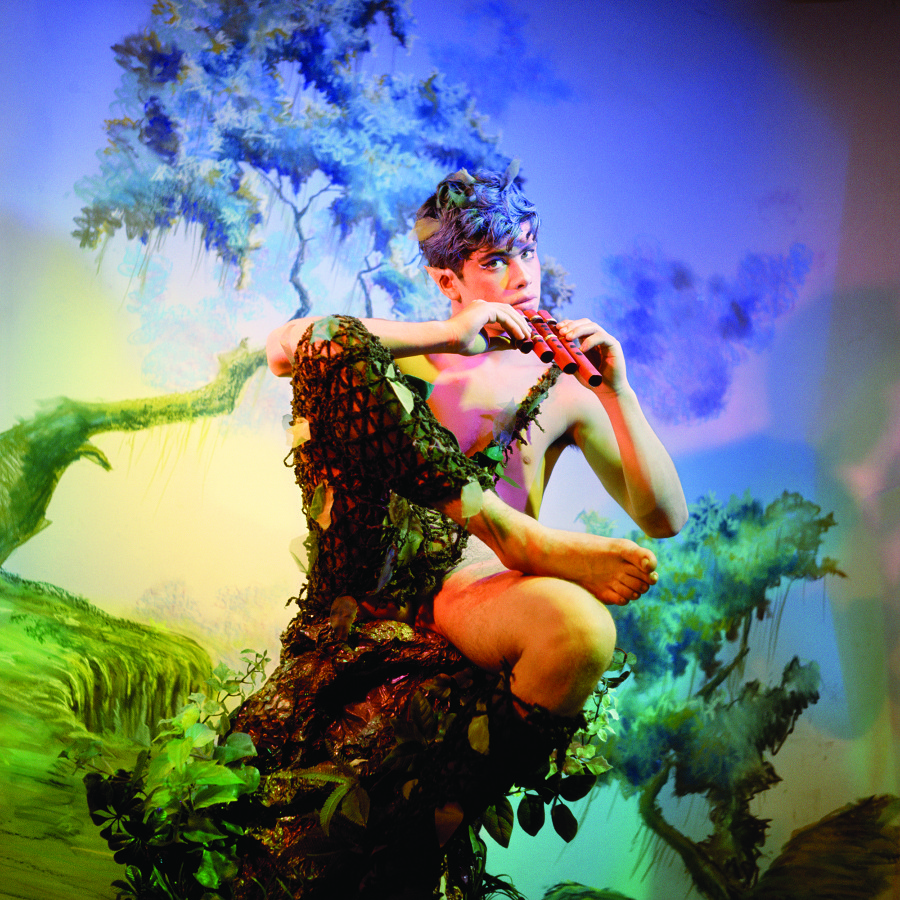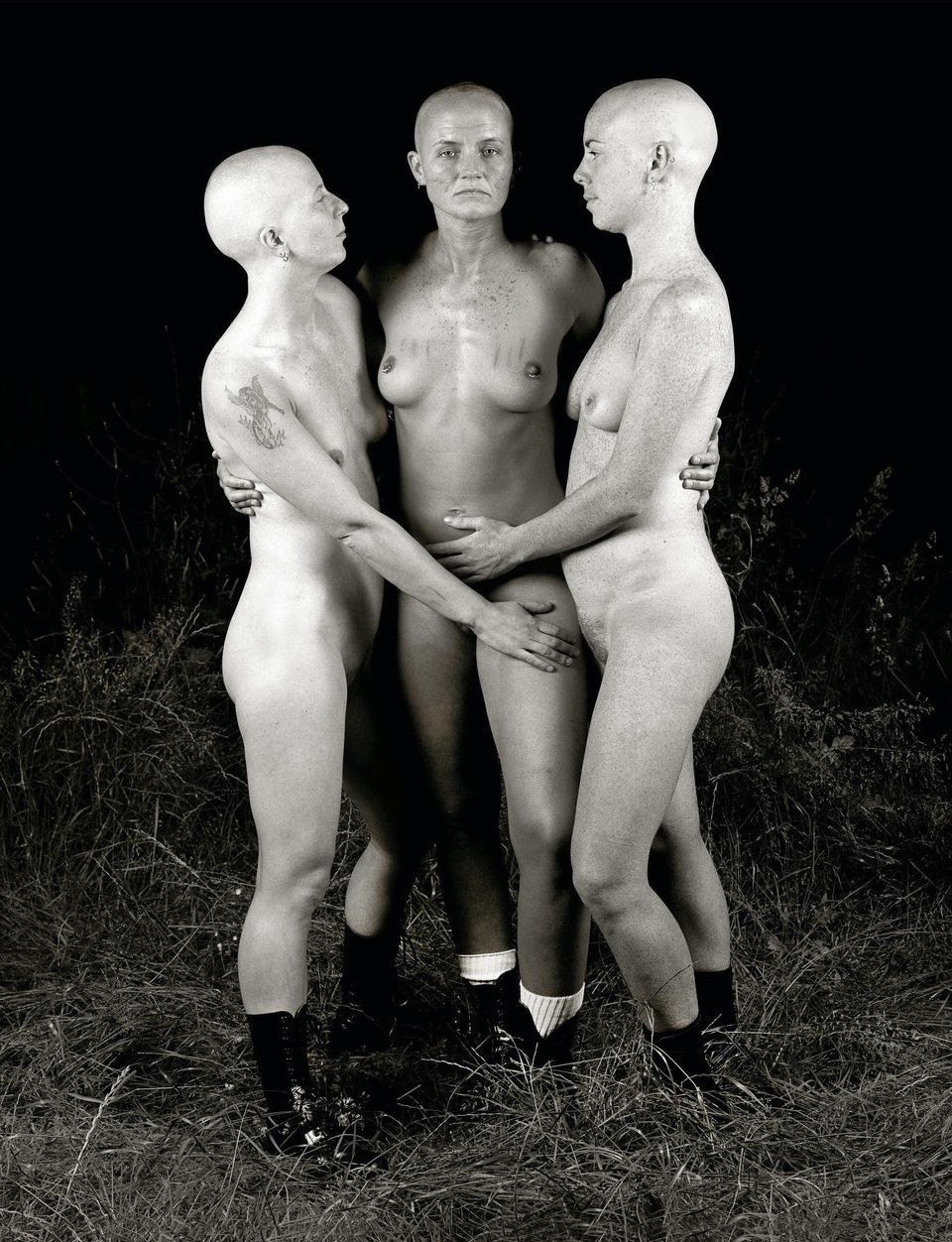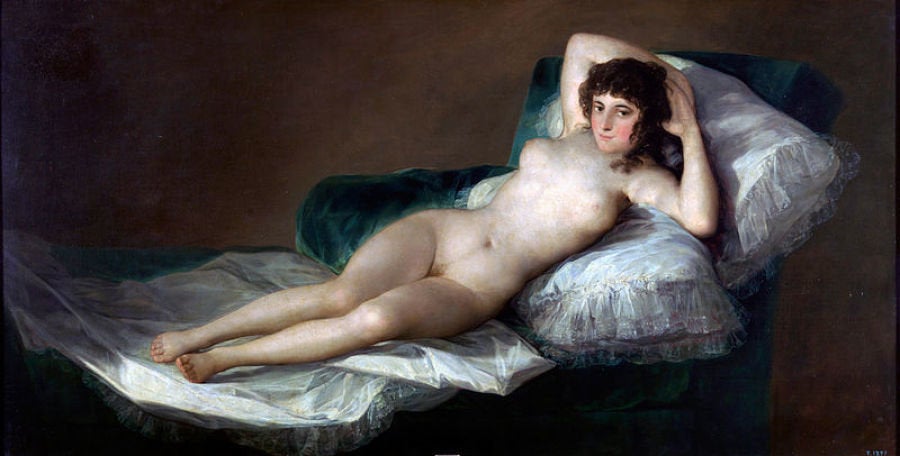There are few themes that connect the centuries and centuries of art history like the nude. Sublime landscapes and posed portraits make their fair share of reappearances over the years, shaped by movements from Mannerism to net art. But there's no popular object more prolific as a nude body, popping up in the oeuvres of Rubens to Degas, Jenny Saville to Ryan McGinley.
A new exhibition at Leslie-Lohman Museum of Gay and Lesbian Art is taking a comprehensive look at the ways in which artists, from antiquity to present day, have imagined the naked body. Showcasing over 100 objects of painting, photography, sculpture, video, drawing and print, the show will tackle the nude in typical Leslie-Lohman fashion: by exploring the space between binary definitions of sexuality and gender.

James Bidgood, Pan, 1965, C-print, 22 x 22 in., © James Bidgood, Collection of Michael Sodomick.
“For over 2,500 years, we have cohabited with one aesthetic archetype -- by far the longest such relationship in the western canon: the classical nude," exhibition curator Jonathan David Katz explained in a press statement. "Not only is it the longest lasting, most influential visual form for representing the human body up to the present day, but also it has become so powerfully naturalized as merely ‘the nude’ that we have often lost the ability to see it as a specific historical type, with a particular history, geography and canon."
Titled "Classical Nudes and the Making of Queer History," the exhibition is divided into four chronological parts -- the years of Antiquity, the Renaissance, the 18th and 19th centuries, and the movements of modern and contemporary art. Spanning over two millennia, the selection covers not only the evolution of the naked image, but the presentation of same-sex love and homoeroticism too.
While the lines and forms transform drastically over the length of the show, from a 1540 sketch by Michaelangelo to a Zanele Muholi C-print from 2009, rendering the body continues to serve as a means of reflecting the desires and subversions of the times. Sure, the nude spent a good amount of time under the thumb of white, male artists, but more recently women and queer artists -- exploring domesticity, new found independence in the 19th and 20th centuries, and sexual competition -- brought the genre to new heights in the modern age.
"The nude is timeless, because human sexual nature evolved before the stone age and has essentially not changed since –- apart from a few customs," Jonathan Jones wrote for The Guardian last year. You could argue that while customs have only moderately changed, the ways in which societies over time have perceived those customs have changed greatly. This is, as has been the case in many of Leslie-Lohman's shows over the past few years, one way the exhibition seeks to reexamine nude history through a queer lens.
"Classical Nudes and the Making of Queer History" will be on view at the Leslie-Lohman Museum of Gay and Lesbian Art from October 18, 2014 to January 5, 2015.
1498
Albrecht Durer, The Men’s Bath, ca. 1498, Woodcut, 14.438 x 11.125 in. New York Public Library.
1528-1530
Jacopo Pontormo, Study of a Male, 1528-1530, Red chalk on paper, 14 x 6 in. Collection of Mr. and Mrs. Mark Borghi.
1540
Michelangelo Buonarroti, Study of Satyr (The Last Judgement), 1540, Black chalk on paper, 7.25 x 11.75 in. Collection of Mr. and Mrs. Mark Borghi.
1848-1851
Jean Jacques Pradier, Standing Sappho, 1848-1851, Bronze, 33.875 x 14.563 x 13. In. The Dahesh Museum of Art, New York.
1962
Ruth Bernhard, Draped Torso, 1962, Selenium-toned silver gelatin print, 12.75 x 8.25 in. © Ruth Bernhard Estate. Courtesy Peter Fetterman Gallery, Santa Monica.
1890s
Florine Stettheimer, Nude Study, Standing with Hands Clasped, late 1890s, Oil on canvas mounted on board, 30 x 18 in. Columbia University.
1894
Jean-Leon Gerome, The Serpent Charmer, 1894, Photogravure, 7.75 x 11.75 in. Museum Purchase. Collection of Leslie-Lohman Museum.
N.D. (1876-1930)
Friedrich O. Wolter, Drei Grazien, n.d., Photograph, 5.5 x 3.5 in. Foundation purchase. Collection of Leslie-Lohman Museum.
1930s
Wilhelm von Gloeden, Untitled, ca. 1930s, B/W photograph glued to board. Foundation purchase. Collection of Leslie-Lohman Museum.
1965
James Bidgood, Pan, 1965, C-print, 22 x 22 in., © James Bidgood, Collection of Michael Sodomick.
1937
Herbert List, Beneath the Poseidon Temple, 1937, Silver gelatin print, 11.614 x 10.827 in. © Herb Ritts Foundation. Collection of William Zewadski.
1992
Del LaGrace Volcano, The Three Graces (Jasper, Suzie & Gill, London) 1992, Digital c-print, 23.5 x 30 in. © Del LaGrace Volcano. Foundation Purchase. Collection of Leslie-Lohman Museum.
2009
Zanele Muholi, Caitlin and I, 2009, C-print, 17.125 x 23.75 (triptych). © Zanele Muholi. Courtesy of Yancey Richardson Gallery, New York.
Support HuffPost
Our 2024 Coverage Needs You
Your Loyalty Means The World To Us
At HuffPost, we believe that everyone needs high-quality journalism, but we understand that not everyone can afford to pay for expensive news subscriptions. That is why we are committed to providing deeply reported, carefully fact-checked news that is freely accessible to everyone.
Whether you come to HuffPost for updates on the 2024 presidential race, hard-hitting investigations into critical issues facing our country today, or trending stories that make you laugh, we appreciate you. The truth is, news costs money to produce, and we are proud that we have never put our stories behind an expensive paywall.
Would you join us to help keep our stories free for all? Your contribution of as little as $2 will go a long way.
Can't afford to donate? Support HuffPost by creating a free account and log in while you read.
As Americans head to the polls in 2024, the very future of our country is at stake. At HuffPost, we believe that a free press is critical to creating well-informed voters. That's why our journalism is free for everyone, even though other newsrooms retreat behind expensive paywalls.
Our journalists will continue to cover the twists and turns during this historic presidential election. With your help, we'll bring you hard-hitting investigations, well-researched analysis and timely takes you can't find elsewhere. Reporting in this current political climate is a responsibility we do not take lightly, and we thank you for your support.
Contribute as little as $2 to keep our news free for all.
Can't afford to donate? Support HuffPost by creating a free account and log in while you read.
Dear HuffPost Reader
Thank you for your past contribution to HuffPost. We are sincerely grateful for readers like you who help us ensure that we can keep our journalism free for everyone.
The stakes are high this year, and our 2024 coverage could use continued support. Would you consider becoming a regular HuffPost contributor?
Dear HuffPost Reader
Thank you for your past contribution to HuffPost. We are sincerely grateful for readers like you who help us ensure that we can keep our journalism free for everyone.
The stakes are high this year, and our 2024 coverage could use continued support. If circumstances have changed since you last contributed, we hope you’ll consider contributing to HuffPost once more.
Already contributed? Log in to hide these messages.














